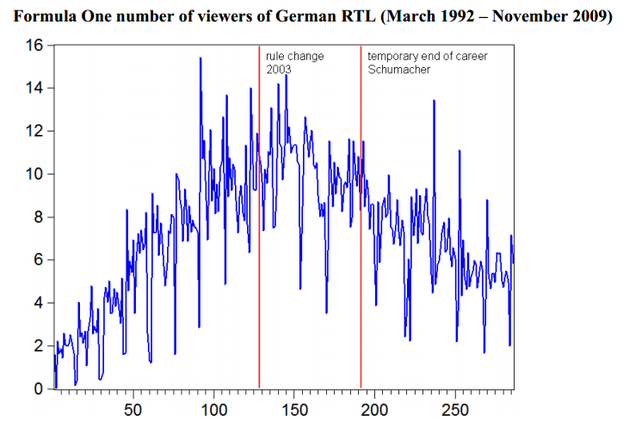Competitive balance has long been a problem in the world’s premier category of motorsport which is due largely to the spending power of the big teams such as Red Bull and Ferrari. In a previous post here. I eluded to the huge differences in spending between the smaller and larger constructors.
One result of low competitive balance is a fall in the number of global fans tuning in. Formula One Management published a media report in January confirming that viewing figures have fallen by 50 million to 450 million viewers. The drop is due to F1’s unattractiveness to the casual viewer. In seasons of close racing casual TV audience members boost up the numbers, but those viewers will tune in only if the show is exciting. It would be akin to the prawn sandwich brigade staying away from Old Trafford during a prolonged period of mid table finishes.
In TV audience terms Formula One doesn't get anywhere near the Premier League. The reason for this is because the teams are very unbalanced due to their spending capabilities. This financial difference, if compared to football, would equate to a Premier League made up of Chelsea, Liverpool, Manchester City, Arsenal, Leeds United, MK Dons, Gillingham and Walsall. Efforts are underway with the FIA to try to limit how much money teams can spend in one season with a planned resource restriction agreement; however, this is unlikely to reach unanimous consent among F1’s heavyweights.

What attracts viewers to the Premier League is the propensity for teams to be relatively evenly matched. On a far greater scale than in F1 any team can potentially beat any other team on any given match day. Norwichcan be demolished 7-0 by ManCity, but then hold them to a goalless draw at home, as happened recently. Some F1 teams have been competing for four seasons and have never scored a point in an era when points are awarded to the
top 10 drivers instead of the top six. The chances of an F1 'giant killing' are not on the cards.
F1 has enjoyed large audiences in Germany which is due in part to the dominance of Vettel, Schumacher and Mercedes. What is striking, however, is that during these periods of dominance viewing figures had an upward trend. The graph shows that between 1992 and 2009 German audiences were highest when Schumacher was most dominant. More fans tuned in to watch him pick up his 7th World Title than watched the dramatic climax of the 2008 season when Massa lost out to Hamiltonin the final corner of the final lap of the championship.
Globally, it seems there is the desire to see a close duel at the top of the standings but within individual territories a
high level of competitive balance is not the priority for the viewers. Formula 1 needs to be more competitive, the FIA needs to turn up the heat to put the fans in a spin!

 RSS Feed
RSS Feed